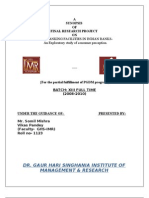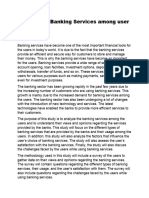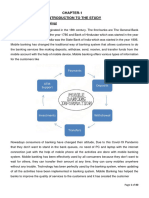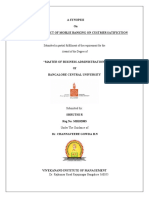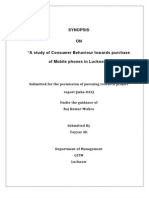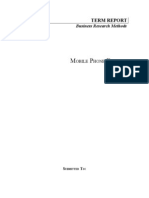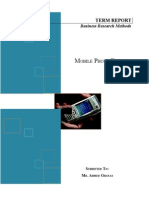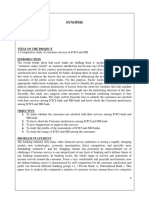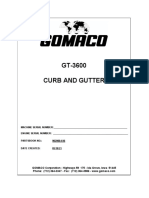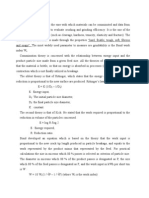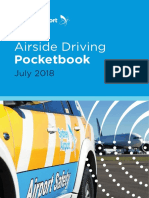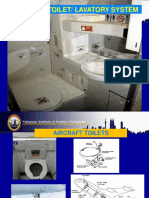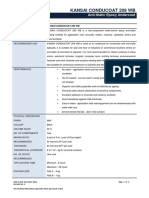CHAPTER-3
RESEARCH METHODOLOGY
Page | 16
�A - Research Gap
After reviewing the existing literature, it is found that, there are few studies conducted on
customer perspective of mobile banking services. On further review it is found that, there
is no specific study on challenges and benefits faced by customers confined to Mysore city,
which gives rise to study the same, in order to fill the gap.
B - Statement of the problem and Justification of the Study
People used to have to spend three to four hours to get to the bank for a transaction, which
could cost more than the money placed or withdrawn. Customers can execute financial
transactions on a secure website using e-banking. In the current context, advances in mobile
technology enable for more convenient and effective distribution of financial products and
services than traditional banks. Customers can use Mobile Banking to move money
between banks, view balances or mini statements, make requests, pay utility bills, and pay
credit cards. However, there are some drawbacks to utilizing mobile banking, such as the
fact that it is not available on all mobile phones and that frequent usage of mobile banking
may result in additional fees.
C – The Need for the study
Mobile banking is a good option for the banking industry to increase the customers. With
the help of mobile telecommunication technology customers make numerous transactions
in the bank at anytime.
The primary need for the study is to identify to what extent the customers are aware of
mobile banking and satisfied with the transactions of mobile banking.
The secondary need is to study the challenges and difficulties faced by the customers while
using mobile banking and how quickly they are adapting to mobile banking.
D – Objectives of the Study
1. To study the innovative banking services in modern days.
2. To highlight the importance of mobile banking services.
3. To study the perception of customer towards mobile banking services in Mysore city.
4. To evaluate the benefits of mobile banking services.
5. To highlight the challenges of mobile banking services.
Page | 17
�E - Scope of the study
The scope of the study encompasses challenges and benefits of mobile banking services
faced by the customers. The geographically who have been using mobile banking services
in Mysore city is targeted for the study.
F - Research Methodology
The Research Methodology is the process which is adopted by the researcher in collecting
and analysing the information on the research topic. In present study, both the primary and
secondary data are taken into consideration, along with the 5-point Likert’s scale
questionnaire.
• Sources of Data Collection
A good research design has characteristics viz, problem definition, time required for
research project, and estimation of expenses to be incurred, the function of research design
is to ensure that the required data are collected and they are collected accurately and
economically. A research design is purely the framework for a study that guides the
collection and analysis of data. The present study is a blend of descriptive, analytical, and
empirical data. An attempt has been made to identify the challenges and benefits of mobile
banking and its impact with the help of primary data. Besides this, secondary data is also
used to understand. For primary data statistical method are being widely used and
hypothesis has been tested with the help of appropriate method.
Data collection is the process to gathering information about the relevant topic research.
Data Collection usually takes place early in an improvement project, and is often
formalized through data collection plan which often contains the following activity
Pre collection activity on goals, target data, definitions and methods.
➢ Collection of Data.
➢ Presenting findings involving some form of sorting analysis. For accomplishing the
objective of study, both Primary and Secondary data have been used.
Data can be classified under two categories depending upon source utilized.
These categories are
➢ PRIMARY DATA
➢ SECONDARY DATA
1. Primary Data: The study is largely based on the primary data which has been
collected through the structured Questionnaire Method.
Page | 18
�2. Secondary Data: This type of data has already been collected by someone else and
has already passed through statistical process.
This type of data has been collected from the following resources:
➢ Internet
➢ Books
➢ Journal
➢ Thesis
➢ News Papers
➢ Government Gazettes
➢ Magazines etc.,
For this study Primary Data has been used for research topic.
• Sample Size and Design:
➢ Population : Population means the whole universe of study in which the researcher
does his study / research and the population for the current research is people of Mysore
city.
➢ Sample Design: The complete study of all items in the population is known as a census
enquiry. Sample is a group of few items, which represents the population or universe from
where it is taken. The Process of Selecting sample have been done using convenient
sampling. At this stage Mysore region have been selected with the help of Convenient
sampling. The size of sample is 100 respondents.
➢ Questionnaire: A questionnaire is a research instrument consisting of a series of
questions and other prompts for the purpose of gathering information from respondents.
Although they are often designed for Statistical Analysis of the responses.
A well Structured Questionnaire consisting of the 5-point Likert‟s scale is being
administered with close end and open end questions to ascertain the customers perception
towards mobile banking services
➢ Research plan:
Data Source - Primary Data Research Approach - Survey Research Instrument -
Questionnaire Method of Contact - Personal Sample Size - 100 Respondents.
• Statistical Tools:
➢ Mathematical Tools: Percentage Method
Page | 19
� ➢ Mathematical Tools: --
In the present research work, mathematical tools are used. It includes the percentage and
simple average method to the analysis and interpretation or collection of data. A
Percentage frequency distribution is the display of data that specifies the percentage of
observations that exist for each data points. It is particularly useful method of expressing
the relative frequency of survey responses and other data. The mathematical method is
using the following tools which are given as below:
➢ (1) Percentage Method –
It was used to draw specific inferences from the collected data that fulfil the objective of
the study. The formula used was:
P = Q/ R * 100
P = Reading in Percentage
Q= Number of respondents falling in specific Category to be measured
R = Total Number of respondents or it is the population.
• Population and Sample
The sample population considered for this study is well defined. Since the study focuses
on the challenges and benefits of customers with respect to mobile banking services, by
using convenient sampling method, out of total population of consumers in Mysuru, 100
consumers who belong to Mysuru city are considered as respondent sources.
G - Delimitations of the Study:
1. The Study of the Project is limited only to Mysore City
2. The sample size of the Project is restricted to only 100 respondents
H - Chapter Scheme:
• Chapter 1 - Introduction :
Under this chapter nature of customers, meaning and definition of mobile banking will be
discussed.
• Chapter 2 - Conceptual Framework :
Under this chapter what are the concepts of mobile banking, what are the benefits and
challenges faced by customers with respect to mobile banking services will be discussed.
• Chapter 3 –profile of the Mysore city :
This chapter covers profile of the Mysore city such as geography, economy,
demographics, industrial profile etc..,
Page | 20
�• Chapter 4- Data Analysis &Interpretation :
Under this chapter a detailed analysis of independent variables and dependent variables
and results will be analysed and interpreted.
• Chapter 5 - Summary of Findings, Suggestions & Conclusion :
In this chapter the major findings will be arrayed at first, subsequently appropriate
conclusion will be drawn. Constructive suggestions will be provided.
• Chapter 6 - bibliography :
It includes refferences which are used for the study.
Page | 21

